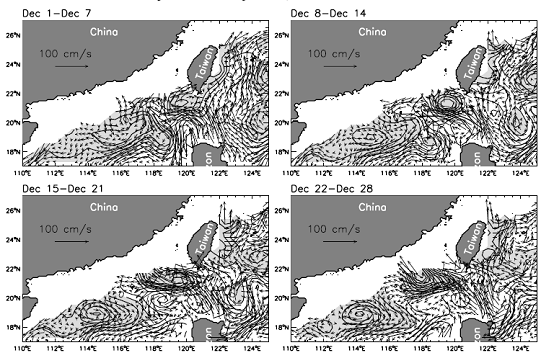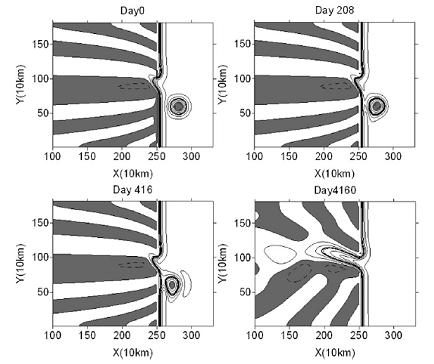Recently, studies by the scientists in the CAS Key Laboratory of Ocean Circulation and Waves at the Institute of Oceanology of the Chinese Academy of Sciences (IOCAS) in Qingdao have made significant advancement in the study of the Kuroshio variability in the vicinity of the Luzon Strait. Analyses have shown that the Kuroshio path varies at the intra-seasonal time scales, rather than seasonally as traditionally believed, in the vicinity of the Luzon Strait between Taiwan and the Philippines. The dynamics of the intra-seasonal variability are disclosed by their recent publication titled “Hysteresis and dynamics of a western boundary current flowing by a gap forced by impingement of meso-scale eddies” in the May 2011 issue of Journal of Physical Oceanography, one of the most authentic international journals on physical oceanography studies.
The Luzon Strait is the major channel of water exchange between the South China Sea and the open ocean. The importance of the Luzon Strait circulation is further evidenced by the fact that the western boundary current of the north Pacific subtropical gyre, the Kuroshio, flows by the strait to reach the East China Sea. The water exchange between the Kuroshio and the South China Sea is thus important to the climate and environment of the northern China seas. Traditionally, the path of the Kuroshio in the Luzon Strait is thought to vary seasonally. Some even believe that the Kuroshio forms a permanent loop in the northern South China Sea year round. These erroneous descriptions of the Luzon Strait circulation pattern have handicapped the understanding of the regional circulation and its climatic and environmental effects significantly.
Using multiple variables of modern satellite observations, Yuan et al. (2006) disclosed for the first time that the Kuroshio path in the Luzon Strait features dominant intra-seasonal variability. Yuan and Li (2008) further show that meso-scale eddies sometimes can perturb the path of the Kuroshio. Wang et al. (2008) have shown that meridional winds can induce change of the path of the Kuroshio through the surface Ekman transport. It is not until Yuan et al. (2011) that the dynamics of the intra-seasonal variability of the western boundary current of different Rossby deformation radii flowing by a gap is disclosed to be forced by the impingement of meso-scale eddies from the eastern sides of the strait. The series of publications have uncovered the primary patterns and dynamics of the Kuroshio variability in the vicinity of the Luzon Strait, which is of great importance to the study of the regional circulation and its climate and environmental effects.
Yuan, D., and R. Li, 2008: Dynamics of the eddy-induced Kuroshio variability in the Luzon Strait. J. Trop. Oceanogr., 27(4), 1-9. (in Chinese with English abstract)..
Yuan, D.,W. Han, and D. Hu, 2006. Surface Kuroshio path in the Luzon Strait area derived from satellite remote sensing data, Journal of Geophysical Research, 111, C11007, doi:10.1029 /2005JC003412
Wang, Z., D. Yuan, and Y. Hou, 2010. Effects of meridional winds on a gap-leaping western boundary current. Chinese J. Oceanol. Limnol., 28(2), 354-358.
Yuan, D., and Z. Wang, 2011. Hysteresis and Dynamics of a Western Boundary Current Flowing by a Gap Forced by Impingement of Mesoscale Eddies. J. Phys. Oceanogr., 41, 878-888, doi:10.1175/2010JPO4489.1
图1. Kuroshio variability in the vicinity of the Luzon Strait observed by satellite altimeters.

图2. Numerical simulation showing the WBC path perturbed by a meso-scale eddies. [From Yuan and Wang (2011)]
|
|

Address: 7 Nanhai Road, Qingdao, Shandong 266071, China
Tel: 86-532-82898902 Fax: 86-532-82898612 E-mail: iocas@qdio.ac.cn


